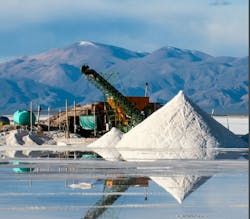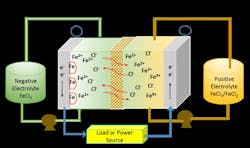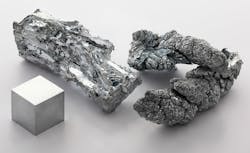The Electrode Less Traveled: Alternatives to Li-Ion in Long Duration Energy Storage
Lithium-ion chemistries are contained in an overwhelming majority of applications for consumer electronics, electric vehicle batteries, and microgrid and utility-scale energy storage projects. The world is exploring newer supply chain opportunities to meet lithium demand, including new mining sites in the U.S. and North America.
And yet the world’s most common large battery element is not without its dramatic shortcomings. In fact, its limitations as a short-duration energy storage resource are pushing competitors to seek longer and more durable options if the energy transition is to evolve into a nearly 100% electrified society.
Options are out there, although they are way behind in scale and immediate demand when compared to lithium. Alternatives include iron-flow, silicon anode, and zinc elements, among others.
The world has plenty of lithium at its disposal, but healthy competition bringing other chemistries on board is good for consumers and the long-term supply prospects of battery storage in the transportation, microgrid, and utility-scale sectors.
“As more renewable energy is added to the grid, storage with longer durations will be essential to provide reliable, resilient electricity when the sun is not shining and the wind is not blowing,” said a spokesman with ESS Inc., which develops and installs its longer duration iron-flow storage technology in a variety of utility, commercial, and industrial sites. “Traditional lithium-ion batteries are most commonly deployed for relatively short durations, two to four hours, which do not provide adequate capacity to balance intermittent wind and solar and provide clean energy 24/7.”
Discharge longevity, to coin a term, is key here. It’s not only about how low you can go, but how long you can go that could be key to chipping away at lithium ion’s previous and future dominance in the battery marketplace.
Temperature Extremes: Cold Starts to Thermal Runaway
Another big disadvantage to lithium-ion is that it decreases in capacity under reduced temperatures.
“A lithium-ion battery works via the active motion of materials inside of it. As the temperature decreases, these materials naturally move slower at non-optimal conditions,” Michelle Tokarz, Vice President of Partnerships and Innovation at Coretec Group, a U.S. battery developer working on silicon anode antidotes to improve battery performance in extreme temperatures.
“The electrolyte [of li-ion] … is liquid and becomes thicker and more sluggish with decreasing temperatures, thereby causing the lithium ions to move slower,” Tokarz noted. “The electrolyte also has lower ionic conductivity at low temperatures, decreasing battery efficiency. Another complication is that at lower temperatures, lithium can readily plate onto the graphite electrode, which may short-circuit the battery, causing a thermal runaway fire.”
Thermal runaway is a central fear for those on the fence about battery storage – they care more about the potential for fire more than range limitations and charging availability. And the threat of fires is a real possibility; four years ago, a thermal runaway event at Arizona Public Service’s battery array in Surprise, Arizona injured numerous first responders.
Lithium-ion is clearly the elemental leader, and it brought us to this energy transition inflection point to lower carbon resources. It balances and supports solar and wind energy while also powering many new battery-electric cars and trucks entering the market. What’s that line about dancing with the one who brought you?
Finding New Partners on the Dance Card
So, of course, those who work in iron flow, zinc, and other energy storage technologies promote how their element is so much better than the predominant li-ion, and in some cases, the science supports their claims.
According to reports, this availability has kept price swings at a minimum compared to lithium’s stretched-out supply chain. Zinc also has up to a 20% longer lifespan than lithium-ion.
“While zinc batteries eventually will be used in both stationary and non-stationary storage applications, in the near-term, zinc’s growing role in long-duration storage can free up the lithium supply for the increasing demand in the electrification of the transportation sector,” said Josef Daniel-Ivad, Manager of the Zinc Battery Initiative at the International Zinc Association.
Iron flow batteries, for example, can offer up to 12 hours of discharge duration, triple that of many lithium-ion applications, according to ESS. The company uses a stack of carbon plates and saltwater where iron flows through each layer and sticks to the plates. The basic technology dates back to the early 1980s.
“Iron flow batteries offer unlimited cycling and long system life with zero capacity degradation, delivering significant cost savings and revenue opportunities over the lifetime of the system,” said the ESS spokesperson. “This makes iron flow technology one of the most cost-effective storage technologies over a 25-year design life, particularly in applications that require frequent cycling and long duration.”
Silicon anodes reportedly avoid the plating issues of li-ion at low temperatures. They also can elevate the quality of charge within li-ion systems.
“Currently, most, if not all, anodes in a lithium-ion battery have some percentage of a conductive material (either as an additive or coating) that boosts the over-conduction of lithium ions,” Coretec Group’s Tokarz said. “Given the tremendous opportunity with silicon’s 10X charge capacity, finding a way to boost the conduction is absolutely worthwhile.”
Zinc might compete with li-ion as well, but proponents say it also offers a way to complement the resource, allowing the element supply chain to focus on the electric revolution of the transportation sector.
Can and Should the King be Dethroned?
Taken in context, lithium is not going away, and its competitors know that. The key goal for alternatives in energy storage is to fill gaps in the supply chain and offer options to strengthen and create work-around routes for supply chains.
The future is going to switch to being increasingly electric. The journey and battles to fill that future are underway.
About the Author
Rod Walton, EnergyTech Managing Editor
Managing Editor
For EnergyTech editorial inquiries, please contact Managing Editor Rod Walton at [email protected].
Rod Walton has spent 17 years covering the energy industry as a newspaper and trade journalist. He formerly was energy writer and business editor at the Tulsa World. Later, he spent six years covering the electricity power sector for Pennwell and Clarion Events. He joined Endeavor and EnergyTech in November 2021.
Walton earned his Bachelors degree in journalism from the University of Oklahoma. His career stops include the Moore American, Bartlesville Examiner-Enterprise, Wagoner Tribune and Tulsa World.
EnergyTech is focused on the mission critical and large-scale energy users and their sustainability and resiliency goals. These include the commercial and industrial sectors, as well as the military, universities, data centers and microgrids. The C&I sectors together account for close to 30 percent of greenhouse gas emissions in the U.S.
He was named Managing Editor for Microgrid Knowledge and EnergyTech starting July 1, 2023
Many large-scale energy users such as Fortune 500 companies, and mission-critical users such as military bases, universities, healthcare facilities, public safety and data centers, shifting their energy priorities to reach net-zero carbon goals within the coming decades. These include plans for renewable energy power purchase agreements, but also on-site resiliency projects such as microgrids, combined heat and power, rooftop solar, energy storage, digitalization and building efficiency upgrades.




